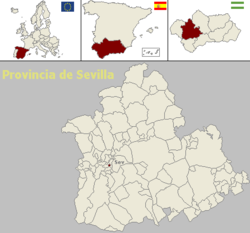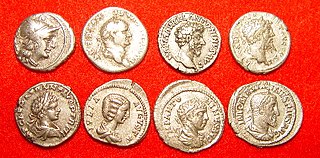
The denarius was the standard Roman silver coin from its introduction in the Second Punic War c. 211 BC to the reign of Gordian III, when it was gradually replaced by the Antoninianus. It continued to be minted in very small quantities, likely for ceremonial purposes, until and through the tetrarchy (293–313).

Isidore of Seville was a Spanish scholar and cleric. For over three decades, he was Archbishop of Seville. He is widely regarded, in the words of 19th-century historian Montalembert, as "the last scholar of the ancient world".

Seville is the capital and largest city of the Spanish autonomous community of Andalusia and the province of Seville. It is situated on the lower reaches of the River Guadalquivir, in the southwest of the Iberian Peninsula.

Electrum is a naturally occurring alloy of gold and silver, with trace amounts of copper and other metals. The ancient Greeks called it "gold" or "white gold", as opposed to "refined gold". Its colour ranges from pale to bright yellow, depending on the proportions of gold and silver. It has been produced artificially, and is also known as "green gold".

The Guadalquivir is the fifth longest river in the Iberian Peninsula and the second longest river with its entire length in Spain. The Guadalquivir river is the only great navigable river in Spain. Currently it is navigable from the Gulf of Cádiz to Seville, but in Roman times it was navigable to Córdoba.

Huelva is a province of southern Spain, in the western part of the autonomous community of Andalusia. It is bordered by Portugal, the provinces of Badajoz, Seville, and Cádiz, and the Atlantic Ocean. Its capital is Huelva.
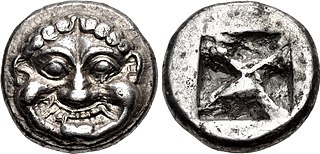
The history of ancient Greek coinage can be divided into four periods: the Archaic, the Classical, the Hellenistic and the Roman. The Archaic period extends from the introduction of coinage to the Greek world during the 7th century BC until the Persian Wars in about 480 BC. The Classical period then began, and lasted until the conquests of Alexander the Great in about 330 BC, which began the Hellenistic period, extending until the Roman absorption of the Greek world in the 1st century BC. The Greek cities continued to produce their own coins for several more centuries under Roman rule. The coins produced during this period are called Roman provincial coins or Greek Imperial Coins.

The siliqua is the modern name given to small, thin, Roman silver coins produced in the 4th century A.D. and later. When the coins were in circulation, the Latin word siliqua was a unit, perhaps of weight defined by one late Roman writer as one twenty-fourth of a Roman solidus.
"Siliqua vicesima quarta pars solidi est, ab arbore, cuius semen est, vocabulum tenens."
A siliqua is one-twentyfourth of a solidus [coin] and the name is taken from the seed of a tree.

Écija is a city and municipality of Spain belonging to the province of Seville, in the autonomous community of Andalusia. It is in the countryside, 85 km east of the city of Seville. According to the 2008 census, Écija has a total population of 40,100 inhabitants, ranking as the fifth most populous municipality in the province. The river Genil, the main tributary of the river Guadalquivir, runs through the city.

Antequera is a city and municipality in the Comarca de Antequera, province of Málaga, part of the Spanish autonomous community of Andalusia. It is known as "the heart of Andalusia" because of its central location among Málaga, Granada, Córdoba, and Seville. The Antequera Dolmens Site is a UNESCO World Heritage site.
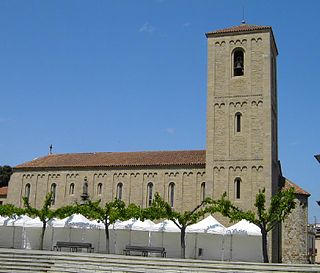
Parets del Vallès is a municipality situated 23 km north of Barcelona, in Catalonia, Spain, in the south-west of the comarca of Vallès Oriental, and 7 km from its capital Granollers. It covers an area of 8,98 km², and has approx. 16,000 inhabitants. From north to south, the town is crossed by the Tenes river. The population is spread over six areas: Barri Antic, on top of the hill surrounding the church; Eixample ("extension"), the most densely populated, laid out in the 1930s; Escorxador ("slaughterhouse"); Can Cerdanet; Can Volart; and Can Riera. The municipality includes a small exclave to the north-west.

Alcalá de Guadaíra is a town located approximately 17 km southeast of Seville, Spain; in recent years the expansion of Seville has meant that Alcalá has become a suburb of that city. Alcalá used to be known as Alcalá de los Panaderos because it provided most of Seville's bread. The town is located on the banks of the Guadaíra River, and watermills built during the Moorish period of Spain can still be found in the area.

La Roda de Andalucía is a municipality of the Province of Seville, Andalusia, Spain. In 2005 it had a population of 4,322 inhabitants and an area of 320 square kilometres (124 sq mi). The density is 56.1 ihhab/km². It is located at an altitude of 405 metres (1,329 ft) and is 123 kilometres from Seville (city).
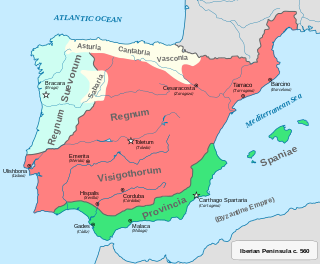
Spania was a province of the Byzantine Empire from 552 until 624 in the south of the Iberian Peninsula and the Balearic Islands. It was established by the Emperor Justinian I in an effort to restore the western provinces of the Empire.

Villanueva del Rosario is a town and municipality in the province of Málaga in the autonomous community of Andalusia in southern Spain. It is located off the motorway from Málaga to Granada and Seville. It is situated in the northeast of the province. It belongs to the comarca of Nororma.
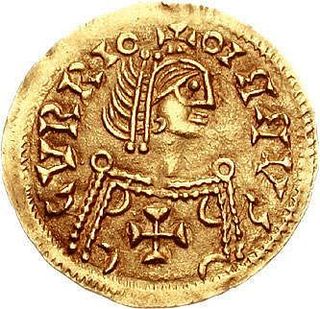
The Visigothic Kingdom or the Kingdom of the Visigoths was a kingdom that occupied what is now southwestern France and the Iberian Peninsula from the 5th to the 8th centuries. One of the Germanic successor states to the Western Roman Empire, it was originally created by the settlement of the Visigoths under King Wallia in the province of Gallia Aquitania in southwest Gaul by the Roman government and then extended by conquest over all of Hispania. The Kingdom maintained independence from the Eastern Roman or Byzantine Empire, whose attempts to re-establish Roman authority in Hispania were only partially successful and short-lived.

Aznalcázar is a town located in the province of Seville, southern Spain. It is only 20 minutes away from Seville, and is one of the 13 towns located in Doñana National Park, one of Spain's most important national parks and wildlife reserves.

Arándiga is a municipality located in the province of Zaragoza, Aragon, Spain. According to the 2004 census (INE), the municipality has a population of 472 inhabitants.
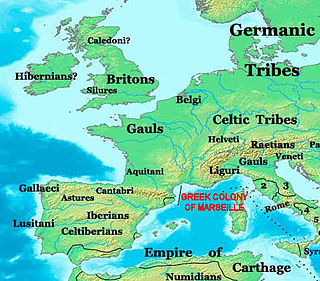
The Greeks in pre-Roman Gaul have a significant history of settlement, trade, cultural influence, and armed conflict in the Celtic territory of Gaul, starting from the 6th century BC during the Greek Archaic period. Following the founding of the major trading post of Massalia in 600 BC by the Phocaeans at present day Marseille, Massalians had a complex history of interaction with peoples of the region.

The biga is the two-horse chariot as used in ancient Rome for sport, transportation, and ceremonies. Other animals may replace horses in art and occasionally for actual ceremonies. The term biga is also used by modern scholars for the similar chariots of other Indo-European cultures, particularly the two-horse chariot of the ancient Greeks and Celts. The driver of a biga is a bigarius.
